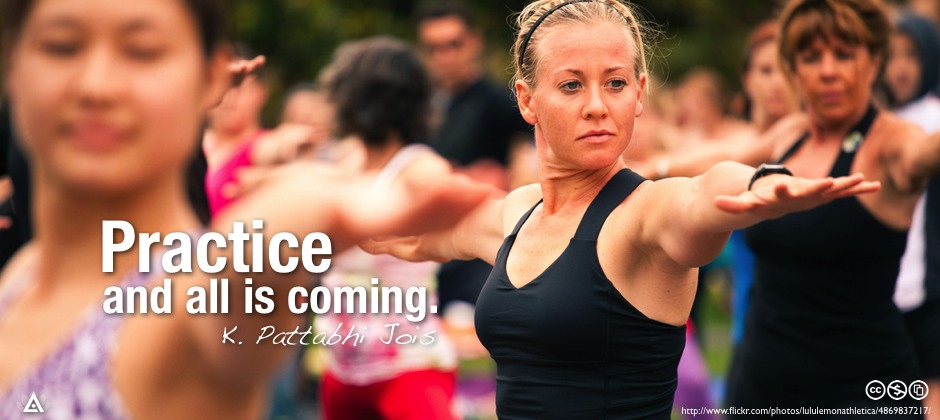
The Fearless•Yoga Methodology
The training methodology for Fearless•Yoga is very straightforward. You will learn a yoga vinyasa series that allows you to build strength, flexibility, balance and body awareness. Just as in traditional Ashtanga Yoga, the movements are done with the full coordination of breathing and concentrated awareness, allowing you to also build focus. Through your daily practice, you're also building "muscle memory" that turns the embedded self-defense techniques into pure reflex.
Your solo daily training consists of a short warm-up that keeps your major joints functioning with full range of motion, followed by a full or partial vinyasa sequence. Depending on your schedule, you can select sequences that take anywhere from ten minutes to one hour to practice.
Next, either in a class setting or independently with a training partner, you will explore the self-defense techniques and practice drills that build automatic reflexes. This is a different kind of "partner yoga" where you're role-playing different scenarios that you might face on the street.
Finally we will explore awareness strategies for staying safe, transforming stress, becoming radiantly healthy, and facing the world with both gratitude and confidence.
Combined, these three phases of training make up what we call Flow, Tactics and Awareness.

FLOW: This is the tapas or "forging" phase where you are building body awareness, strength, flexibility, balance and endurance. Through focus and repetition, you will build "muscle memory" that allows you to move instinctively and effectively. Rather than training from the combat or competition perspective common to the martial arts traditions, we will be building on a foundation of movements and postures commonly practiced in most forms of VINYASA YOGA.
TACTICS: This is the selection phase where you learn to pick the best course of action. You will learn to recognize indicators that tell you which tool is appropriate to the task, and you will learn to use a lot of different tools, which we call "techniques." These techniques will simultaneously stop an intended assault and destroy the attacker's means to hurt you. You will learn to INTERRUPT and INCAPACITATE.
AWARENESS: This is the recognition phase where you learn to effectively observe and orient. Among other things, you will learn about the types of violence, the types of bad guys, how to pay attention to warning signs and how to listen to your instincts and intuition. In other words, you're going to learn to BE A BAD VICTIM.
Because of the way we learn new things, the training order of these three skills is sequential. Each session begins with Flow, followed by the reflex development drills in Tactics, and concludes with a practical lesson from Awareness.
FLOW
 The FLOW PHASE is based on learning and practicing essential body mechanics. We are going to assume that in a violent assault, your attacker is going to be bigger and stronger, so instead of using size and strength we're going to use position and leverage. This requires reflexive skill and an understanding of body mechanics, and we're going to use yoga asana as our foundation.
The FLOW PHASE is based on learning and practicing essential body mechanics. We are going to assume that in a violent assault, your attacker is going to be bigger and stronger, so instead of using size and strength we're going to use position and leverage. This requires reflexive skill and an understanding of body mechanics, and we're going to use yoga asana as our foundation.
First we look at the traditional asana itself, with a special emphasis on understanding the underlying skeletal and muscular structure. Next we look at the vinyasa, or the motions required to move into the asana. Here we're training mechanical efficiency and structural integrity, with a double emphasis on both stability and safety. Finally we look at modifications to the asana. Traditional asanas work with bodyweight and gravity, but we're going to add new vectors or lines of power that arise when human bodies collide. This will enable you to both absorb pressure and generate power.
In the Flow phase the goal is to stay focused on perfecting the movement itself rather than being preoccupied with a tactical outcome. The lessons here blend seamlessly with almost any form of Hatha or Vinyasa Yoga practice, with emphasis on alignment, balance, stability, coordination of breath, and focused concentration.
TACTICS
 The TACTICS PHASE is based on responding to indicators with techniques that allow you to interrupt an attack and incapacitate the bad guy. Whereas in the FLOW phase you are working solo, in the TACTICS phase you begin working with a training partner through exercises called reflex development drills. Early cycles are simple and focus on fundamental body movements. As your skills improve, the techniques will challenge your timing and sensitivity. Remember that the human body and brain are plastic; through ongoing challenge you will adapt and gain strength, flexibility, balance, endurance and effective reflexes.
The TACTICS PHASE is based on responding to indicators with techniques that allow you to interrupt an attack and incapacitate the bad guy. Whereas in the FLOW phase you are working solo, in the TACTICS phase you begin working with a training partner through exercises called reflex development drills. Early cycles are simple and focus on fundamental body movements. As your skills improve, the techniques will challenge your timing and sensitivity. Remember that the human body and brain are plastic; through ongoing challenge you will adapt and gain strength, flexibility, balance, endurance and effective reflexes.
In Tactics, you learn the meaning behind the movements practiced in Flow. We simply add the outcome to the motion, and suddenly those graceful postures become take-downs, throws, joint-locks, chokes and escapes.
The real beauty of the Tactics training is that while you are focused on learning technique, you are also being conditioned to the realities of an assault. The drills are trained at very close range, so you get accustomed to having someone in your personal space. The drills are also trained safely at full power. This is neither "art" nor "fighting fantasy;" you will learn techniques exactly as you would use them in the street.
Real criminal assaults are often shockingly close and brutally powerful in order to overwhelm you. If this ever happens to you, though, your brain won't even blink: you've seen this dozens of times in class already.
Although in the beginning this training may look overwhelming, learning the self-defense tactics is as easy as learning your A, B, C's and 1, 2, 3's. If you can say (or sing) the alphabet and count to ten, you've proven that you can learn 36 concepts. And that's all we're talking about: 36 core concepts that will keep you safe.
AWARENESS
 The AWARENESS PHASE hones your skills to observe and orient so that you're able to understand what's going on and react appropriately. This phase puts FLOW and TACTICS into context. The most important aspect? Don't panic. At this point in the training, you already know what to do physically to end the assault, so this phase is about FOCUS: stay calm, preserve your energy, select the right technique, and breathe.
The AWARENESS PHASE hones your skills to observe and orient so that you're able to understand what's going on and react appropriately. This phase puts FLOW and TACTICS into context. The most important aspect? Don't panic. At this point in the training, you already know what to do physically to end the assault, so this phase is about FOCUS: stay calm, preserve your energy, select the right technique, and breathe.
Remember, the goal is not to turn you into a fighter, but simply to make you fearless. The priority is to give you strategies to help you avoid and evade any potential assault, and the confidence to know that you can handle any truly unavoidable crisis.
The Awareness lessons are not secret techniques handed down from legendary Ninja masters; they're just common sense. We'll discuss how to avoid the predator's hunting grounds, how not to look like prey, and how to activate and utilize your powerful instincts and intuition to keep yourself and your loved ones safe.
Next: The Five Elements
The Fearless•Yoga coursework is built around a progression that moves from basic movements to more complex techniques requiring coordination and timing. The training drills will also progressively challenge your comfort level of physical contact, working from light contact towards "worst-case scenarios."
To help build structure around these training progressions, the lessons are organized into themes that we relate to the yogic concepts of the Five Elements.
